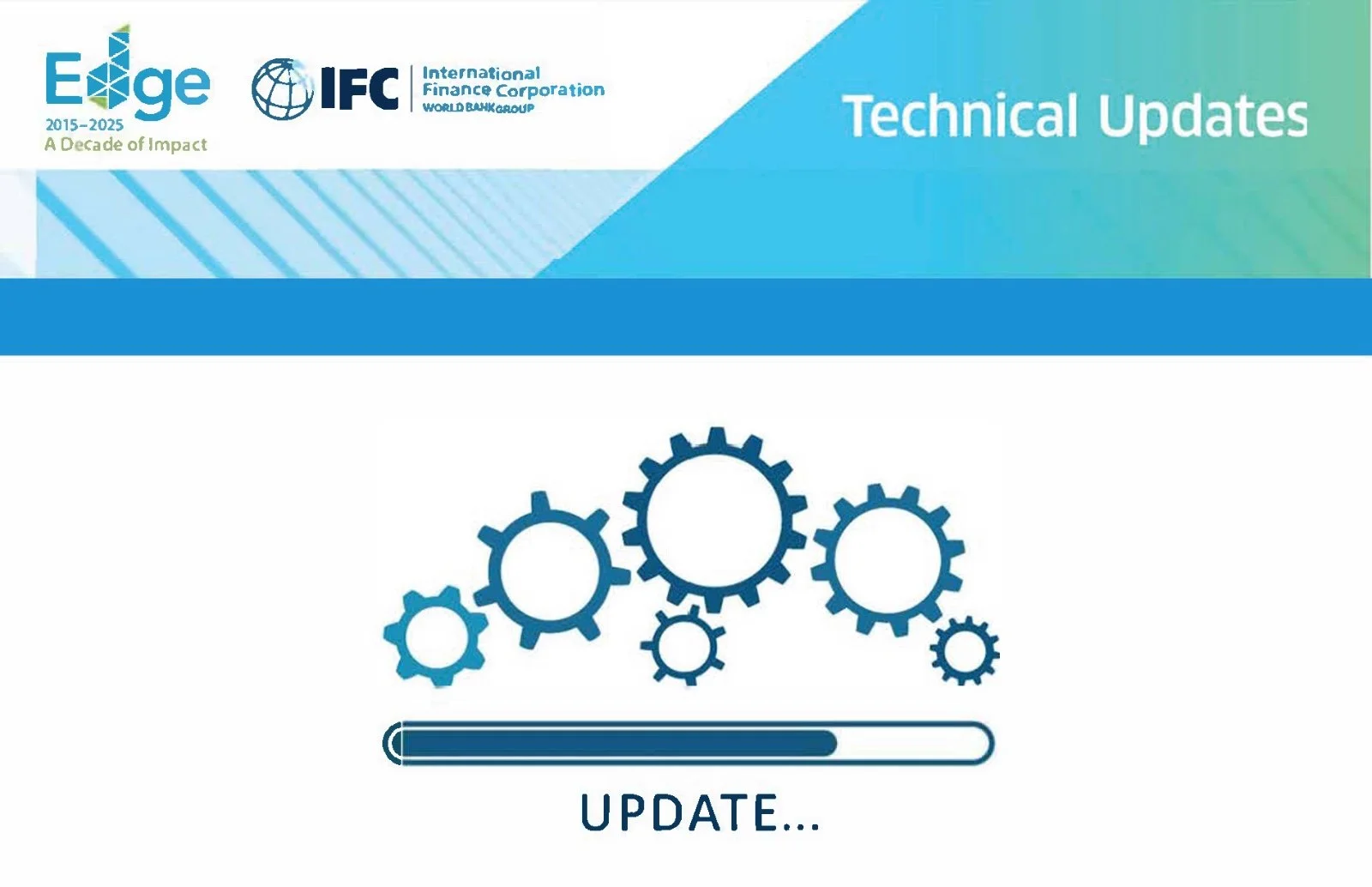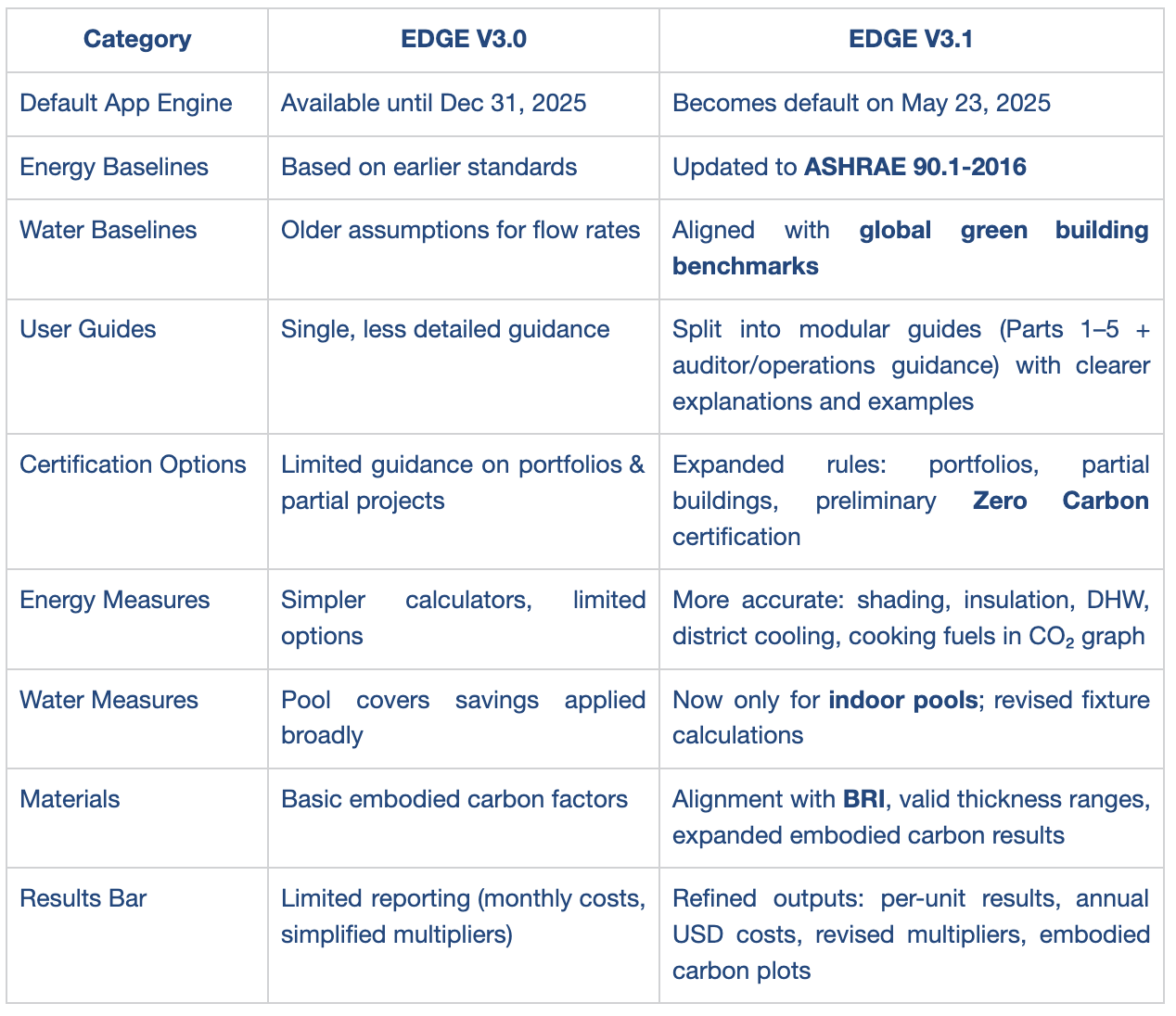Understanding EDGE Version 3.1: Key Updates and Their Impact on Certifying your Project
In the fast-evolving landscape of sustainable construction, building certification tools must continuously adapt to align with new technologies, data, and global best practices. EDGE (Excellence in Design for Greater Efficiencies)—an innovation of the International Finance Corporation (IFC), a member of the World Bank Group—has become one of the most widely recognized platforms for driving green building adoption worldwide.
With the release of EDGE Version 3.1, project teams will encounter a number of important updates that reshape how certification is pursued and awarded. From refined baselines to new certification pathways, these updates are designed to make EDGE more accurate, more relevant, and better aligned with global climate goals.
So, what exactly has changed in EDGE V3.1, and what does this mean for your project?
Transition Timeline: What You Need to Know
Before diving into the technical details, it’s important to understand the transition roadmap:
EDGE V3.1 becomes the default version when you access the EDGE App starting May 23, 2025.
EDGE V3.0 registration closes on December 31, 2025. Any project that wishes to remain under V3.0 must be registered before this date.
EDGE V2.1.5 sunsets on June 30, 2026. Projects already in progress under this version have until then to complete certification. After the sunset date, all preliminary certificates issued under V2 will expire without exception.
This means that while existing projects can continue under their registered version (with a limited timeframe), all new projects will need to move toward V3.1. For project owners and consultants, the message is clear: now is the time to get familiar with the new version.
What’s New in EDGE V3.1
1. User Guides Restructured and Expanded
One of the most noticeable changes in V3.1 is the overhaul of the User Guides. Instead of a single, condensed document, the guides are now divided into several parts for easier navigation and clarity:
Part 1 – Building Certification Guidance
Part 2 – Design Tab Guide
Part 3 – Energy Measures
Part 4 – Water Measures
Part 5 – Material Measures
Additional Guides – Auditor Guidance
This restructuring makes the certification process easier to follow while also addressing common challenges faced by project teams. The guides include clearer definitions, more examples, and enhanced explanations for complex measures.
2. Certification Guidance Updates
EDGE V3.1 introduces more specific requirements for certain building typologies and certification pathways:
Industrial Buildings: Must now report all process loads from electricity.
Partially Finished Residential Projects: At least one water-efficient fixture (shower, faucet, WC, kitchen sink) must be installed per unit. If not, a penalty factor is applied.
Core & Shell Projects: Now limited to commercial and industrial projects. Savings can only be claimed through tenant fit-out guides or lease agreements, with strict caps.
Partial Buildings: Eligible if sub-metered, independently schedulable, and physically separated by permanent barriers.
Portfolio and Clustering: Multiple buildings can now be grouped into one subproject with clearer rules for consistency.
Zero Carbon Certification: Aligned with ISO Net Zero frameworks, with updated methodologies for carbon offsets and a new preliminary zero carbon certification option.
3. Software and Calculation Engine Updates
While the interface remains similar to EDGE V3.0, the calculation engine has undergone significant improvements, making results more robust and aligned with international standards.
Some of the key updates include:
Energy:
Baselines now aligned with ASHRAE 90.1-2016, updating cooling efficiencies, lighting power density, and insulation requirements.
Revised calculators for shading, insulation, heating controls, and domestic hot water systems.
District cooling savings updated for Malaysia and UAE.
Water
Global base case flow rates updated to match international certification standards.
Revised calculations for showers, faucets, urinals, and kitchens
Swimming pool savings are now only applicable to indoor pools; outdoor pools excluded.
Materials
Alignment with the Building Resilience Index (BRI).
Embodied carbon results expanded to include insulation and window frames.
Valid thickness ranges and more accurate baseline assumptions for roofing and steel rebar.
Results Bar
More precise multipliers for homes/apartments.
Utility cost savings now displayed per unit (for homes) or per year in USD (for commercial buildings).
CO₂ savings more accurately reflect cooking fuels and plug loads.
EDGE V3.0 vs V3.1: Key Differences
While V3.0 and V3.1 share the same overall framework, the differences are significant in terms of baseline standards, guidance, and calculation methods. In short, V3.1 makes EDGE more demanding, but also more transparent and globally relevant.
To summarize these updates at a glance, the table below highlights the key differences between EDGE V3.0 and V3.1:
EDGE V3.0 vs V3.1 at a Glance
What This Means for Your Project
The transition to EDGE V3.1 has real implications for different stakeholders:
For Developers and Building Owners
Expect stricter baselines that may lower initial savings percentages compared to V3.0.
However, certification under V3.1 demonstrates compliance with stronger global standards, boosting credibility and market appeal.
For Consultants and Auditors
The expanded guides mean clearer instructions, but also a need to study the details carefully.
Pay special attention to fixture requirements, clustering workflows, and carbon offset methodologies.
For the Market
The shift signals EDGE’s continued evolution toward international comparability.
Projects certified under V3.1 will have stronger alignment with other global green building standards.
Looking Ahead
EDGE V3.1 is more than just a technical update; it represents IFC’s commitment to making sustainability measurable, credible, and practical across different markets. While the learning curve may feel steeper at first, the payoff is significant: greater accuracy, stronger alignment with global climate targets, and improved recognition for certified projects.
For project teams, the best approach is to adapt early. Familiarize yourself with the new guides, explore the updated calculation methods, and integrate these requirements into your project strategy from the outset.
Conclusion
As EDGE continues to evolve, so too does the responsibility of project teams to keep pace with new requirements. Version 3.1 raises the bar, but it also provides clearer pathways and better tools for achieving certification. By understanding these changes now, you can ensure your project is well-positioned to meet both today’s certification needs and tomorrow’s sustainability expectations.
At Sustainahaus, we are committed to helping developers, owners, and partners navigate these changes—ensuring that your projects remain not only certifiable, but exemplary in advancing green building practices.
References
EDGE Buildings Resource Portal – Full set of V3.1 User Guides and Technical Updates: https://edgebuildings.com/resources/user-documents/
EDGE Café – Technical Updates in V3.1 (Indonesia, February 20, 2025)
EDGE V3.1 Updates for Experts & Auditors (Email update, November 28, 2024)
Technical Update: EDGE V3.1 as Default Engine (Email update, May 26, 2025)
EDGE Buildings Official Website – https://www.edgebuildings.com

